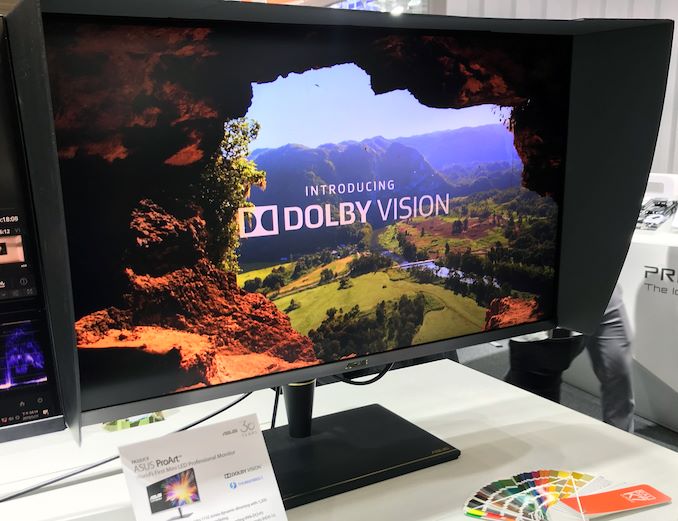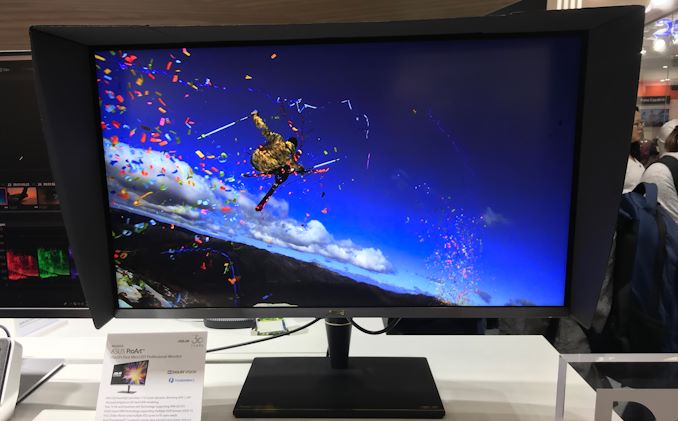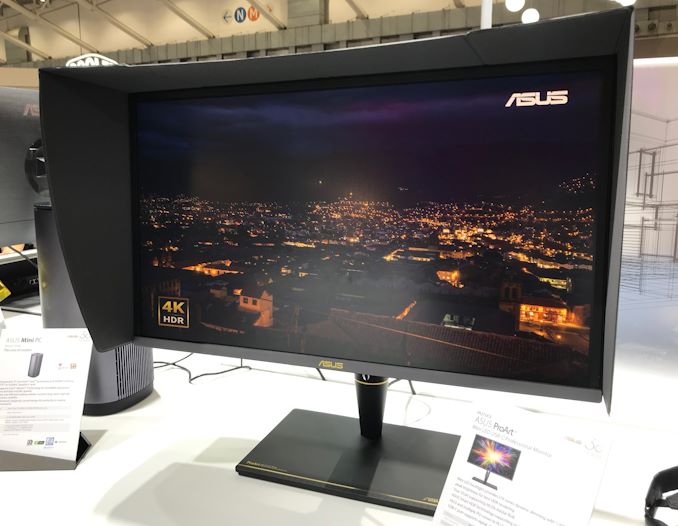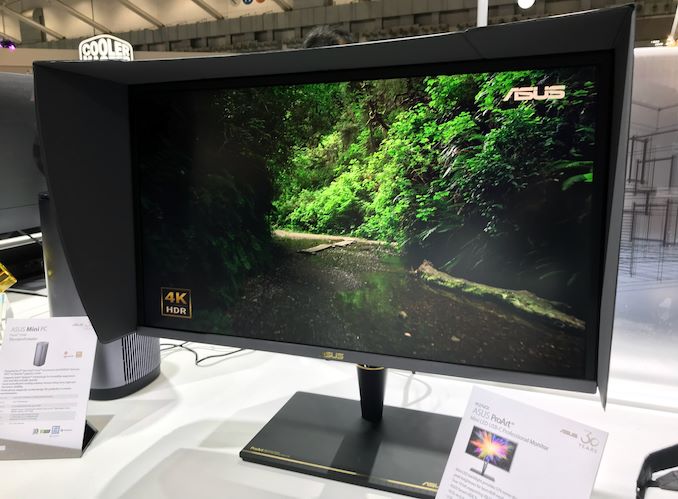ASUS Mini LED Professional Monitors Update: Available This Year
by Anton Shilov on June 14, 2019 8:00 AM EST- Posted in
- Monitors
- Displays
- Asus
- Trade Shows
- 4K
- ProArt
- Mini LED
- Computex 2019

Earlier this year ASUS announced two ProArt displays featuring Mini LED-based backlighting supporting full array local dimming (FALD) aimed at professionals. The ProArt PA32UCX with 1152-zone FALD was introduced at CES, whereas the smaller ProArt PA27UCX with 576-zone FALD was quietly unveiled later on. At Computex, the company provided an update regarding their availability.
The large 32-inch ProArt PA32UCX display with a 1152-zone FALD is nearly ready and will be available sometimes in late June, according to an ASUS representative at the company’s booth. The smaller 27-inch ProArt PA27UCX monitor with a 576-zone FALD is several months behind the flagship, so it is still being polished off. The same rep assured that this LCD will still be available by the end of the year, but refused to reveal any more precise information.
While the ProArt PA32UCX and the ProArt PA27UCX displays are different when it comes to diagonal sizes and the number of FALD zones, they have a lot in common. Both are based on 10-bit IPS panels featuring a 3840×2160 resolution, 1,000 – 1,200 nits peak brightness, a high contrast ratio, and a 60 Hz refresh rate. The monitors are factory calibrated to ΔE < 2 accuracy, they cover 99% of DCI-P3, 89% of Rec. 2020, 99.5% of Adobe RGB, and 100% of sRGB color spaces used for video post-production as well as graphics design nowadays.
Besides, both Mini LED-enabled monitors from ASUS support numerous HDR formats, including HDR10, hybrid log gamma (HLG), and Dolby Vision (the 32-incher only, so far). The two LCDs also meet or exceed requirements for VESA’s DisplayHDR 1000 logo. Last but not least, both displays feature either Thunderbolt 3 or USB Type-C connectivity with 60 W Power Delivery.
| Specifications of the ASUS ProArt Mini LED Displays | |||
| ProArt PA27UCX | ProArt PA32UCX | ||
| Panel | 27" IPS | 32" IPS | |
| Native Resolution | 3840 × 2160 | ||
| Maximum Refresh Rate | 60 Hz | ||
| Response Time | unknown | unknown | |
| Brightness | 1000 cd/m² (peak) | 1200 cd/m² (peak) | |
| Contrast | high | high | |
| Viewing Angles | 178°/178° horizontal/vertical | ||
| HDR | HDR10, HLG | HDR10, HLG, Dolby Vision | |
| Backlighting | Mini-LED-based 576-zone FALD |
Mini-LED-based 1152-zone FALD |
|
| Pixel Pitch | 0.1845 mm² | ||
| Pixel Density | 138 ppi | ||
| Display Colors | 1.07 billion | ||
| Color Gamut Support | DCI-P3: 99% Adobe RGB: 99.5% Rec. 2020: 89% sRGB: 100% |
||
| Aspect Ratio | 16:9 | ||
| Stand | Hight, Tilt, and Swivel adjustable | ||
| Inputs | 1 × DisplayPort 1 × USB-C 1 × HDMI 2.0 |
1 × DisplayPort 2 × Thunderbolt 3 (in/out) 1 × HDMI 2.0 |
|
| USB Hub | USB hub | ||
| Launch Date | Late 2019 | June 2019 | |
Pricing of the ProArt PA32UCX and the ProArt PA27UCX is something that remains to be seen. Evidently, Mini LED-based backlighting is a new technology and costs more than traditional units. Furthermore, both monitors belong to professional pedigree, so expect them to be priced accordingly.
Related Reading:
- ASUS at CES 2019: ProArt PA32UCX 4K Monitor with 1000-Zone FALD Unveiled
- ASUS Shows Off Dolby Vision Monitors: The ProArt PQ22UC & ProArt PA32UCX
| Want to keep up to date with all of our Computex 2019 Coverage? | ||||||
 Laptops |
 Hardware |
 Chips |
||||
| Follow AnandTech's breaking news here! | ||||||














24 Comments
View All Comments
TristanSDX - Friday, June 14, 2019 - link
Mini LED is mistake. It require complex active matrix to drive these hunderds of LED's zones (zone is group of LEDs), this is costly, and there are halos and trailing on finl image.Proper solution is Dual cell LCD, which is cheap, high speed (1ms or below), high contrast in range 1000000:1, fine color reproduction (12 bit with ease from two 6 bit LCD layers). Combined with in-front quantum dots, it give superior image to LCD, mini LED, OLED. Only very matured MicroLED can be better (decade away fron now at least)
akvadrako - Friday, June 14, 2019 - link
What are some of the best cheap dual cell LCD monitors?DanNeely - Friday, June 14, 2019 - link
Forget cheap. Are any for sale at all?AFAIK it's a tech that's been in R&D for over a decade and hyped by parts of the commentariat as the next big thing for almost as long; but for whatever reason has proven impossible to commercialize.
FreckledTrout - Friday, June 14, 2019 - link
I dont know if TristanSDX has anything to do with Hisense but they are the only ones hyping this tech outside of the profesional space of extremely expensive monitors. It has got to be really hard to make these cheaply enough.Beaver M. - Friday, June 14, 2019 - link
Or just uncool. They would be thicker again after all!a5cent - Tuesday, June 18, 2019 - link
To my understanding this isn't correct.An LCD layer is very thin (a few hairs thickness), so adding a second layer would barely increase thickness at all. A monitor's thickness results largely from its backlight. FALD is particularly thick, because it requires the lights to be directly behind the screen rather than at its edges where most laptop monitors have them. A dual layer LCD could combine the thinness of laptop monitors with the performance of desktop monitors.
I'll remain skeptical until I see a test though.
. In fact, compared to the FALD alternative, it is likely to be much thinner as these monitors could
TheUnhandledException - Friday, June 14, 2019 - link
Currently available the cheapest one I am aware of is the Sony BVM-HX310 at a mere $30,000.FreckledTrout - Friday, June 14, 2019 - link
While I do like the dual cell LCD tech I do not know of a single monitor outside of the profesional space that are in the market. I know Hisense was showing some off at CES but those are not for sale yet.I would like to see both dual cell and MicroLED's tested by third party reviews when they do come out to see how they really perform in monitors the masses can afford ie with whatever sacrifices each tech must make to make that possible.
TheUnhandledException - Friday, June 14, 2019 - link
Saying dual layer LCD is "cheap" is just nonsense. There is nothing cheap about it and yields have been so horrible that while it is amazing it has been limited to ultra reference monitors ($10K to $40K). If it was so easy and cheap as you say ... OEMs would just be using it over alternatives.TristanSDX - Friday, June 14, 2019 - link
Professional monitors have their own pricing guide, usually with profits 10x larger than average monitor, while used tech is more refined but not that costly.